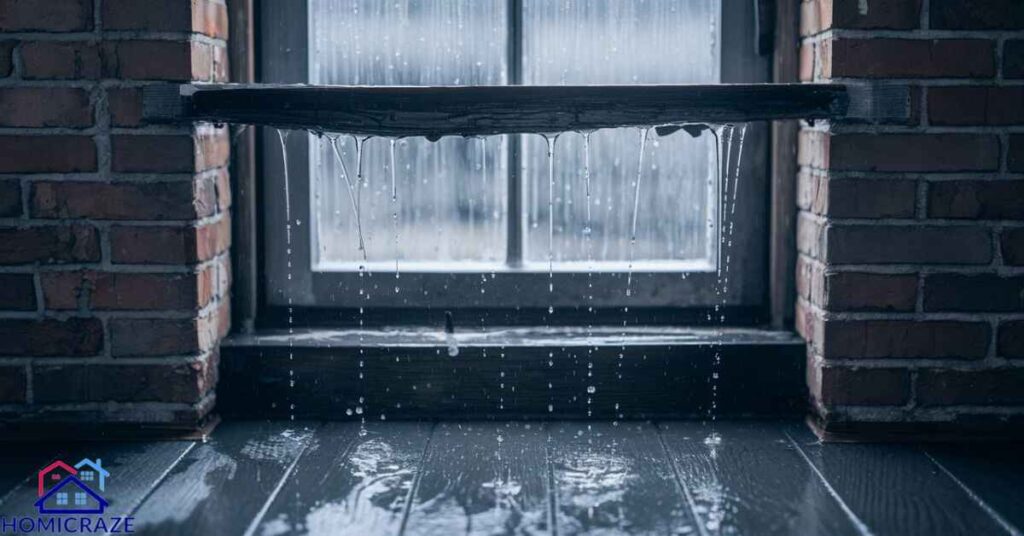Window leaks are more than a minor inconvenience; they’re a hidden risk to your home’s structure and your health. When water seeps through window frames and into your carpet, it doesn’t just cause unsightly stains—it can lead to serious issues like mold growth, rot, and weakened floors. Ignoring these leaks could result in costly repairs and lasting damage.
But with the right approach, you can tackle these leaks head-on, protecting your home from further deterioration. This guide covers everything from detecting leaks to finding effective, long-lasting solutions to keep your windows and carpets dry and secure.
Understanding Window Leaks

Window leaks may start small, but their impact can quickly grow. If not addressed, these leaks can lead to moisture buildup, damaging carpets and floors. When a window leak seeps into the carpet, it can lead to mold, mildew, and even structural rot.
Leaks often begin due to minor issues, but they’re easy to overlook until water starts visibly collecting or spreading. Understanding what causes window leaks and knowing where they often occur is crucial in preventing costly damage to your home’s interior and maintaining a healthy environment.
What Causes Window Leaks?
Window leaks can be traced to several factors, including faulty seals, improper installation, and wear from exposure to harsh weather. Over time, window seals may weaken or crack, allowing water to slip through. Poor installation can leave gaps, and heavy rain can exploit these weaknesses, causing a window leak that seeps into the carpet. These issues are particularly common in older homes where windows may not have been replaced or well-maintained. Regular inspection is essential for catching and addressing these causes before they lead to bigger problems.
Common Types of Window Leaks
There are a few common areas in windows where leaks tend to develop. Most leaks occur around the window frames, sashes, and glazing. Frames may shrink or loosen with age, sashes may warp, and glazing may crack, all allowing water to enter.
When water seeps through, it can trickle down into the carpet, creating a window leak that seeps into the carpet. Catching these types early can save you from future repairs. Regular inspection and quick repairs can help prevent major damage, mold, and costly fixes down the line.
Where Do Windows Normally Leak?
Windows have weak points that are naturally more susceptible to leaks, including the edges of frames, corners, and seals around glass panels. Frames can shift, seals can deteriorate, and corners can become loose over time, especially in climates with heavy rain.
A window leak seeping into the carpet often starts at these vulnerable spots, trickling down from the frame to the floor. Checking for dampness around window edges and on carpets is essential in catching leaks at the source and avoiding widespread damage to your home.
How Do You Check if a Window is Leaking?
Detecting a window leak seeping into the carpet doesn’t require complicated tools. Start with a basic visual inspection—look for cracks, damaged seals, or any water stains around the frame. Try the candle flame test: hold a candle near the edges of the closed window.
If the flame flickers, air may be entering. You can also perform a water spray test: spray water on the outside while someone checks inside for leaks. Simple steps like these can reveal hidden issues before they worsen.
Signs Your Window Seal is Leaking
A leaking seal often shows clear signs. Condensation or fogging between double-glazed panes is a common indicator, as is visible moisture around the edges. You might also notice discolored or peeling areas around the frame.
When seals fail, water can easily penetrate, potentially leading to a window leak seeping into the carpet. This damage not only affects energy efficiency but can also lead to mold and other issues. Regularly checking for these signs can help you catch a leak early and avoid costly repairs.
DIY Leak Detection Techniques

Several DIY methods make it easy to spot leaks. Using a thermal camera, you can scan for cold spots indicating where air or water is entering. Another method is the soap solution test: apply soapy water to the edges and look for bubbles when air escapes.
These techniques are effective for finding drafts and can prevent issues like a window leak seeping into the carpet. Simple detection tools can save money and prevent damage by pinpointing leaks early on, especially during winter or rainy seasons.
Air Leaks: How They Affect Your Home
Air leaks may not seem serious, but they can have a big impact. When there are gaps or cracks in your windows, cold or warm air can easily enter or escape. This means your heating or cooling systems have to work harder, increasing energy bills.
An energy-efficient home relies on airtight windows to keep temperatures stable. Ignoring air leaks can cost you in the long run, especially during extreme weather. Preventing air leaks is key to keeping your home comfortable and reducing costs.
Water Leaks: Damage to Carpets and Floors
A window leak seeping into the carpet can cause lasting damage to floors and nearby walls. When water seeps in, it damages carpets, wooden floors, and even the structure underneath.
Over time, this leads to mold and mildew growth, posing a health risk. Water leaks can also cause floor warping, peeling paint, and damaged insulation. Fixing the source of water leaks quickly protects your interior and prevents expensive repairs from water-damaged carpets and floors.
Condensation Issues and Mold Growth
Condensation around windows is a common issue, especially in colder weather. This excess moisture often leads to mold, which can grow around window frames and sills.
A window leak seeping into the carpet can make mold spread faster. Mold not only damages structures but also affects indoor air quality, posing health risks. Condensation buildup is a sign that windows may need better insulation or sealing. Addressing it promptly helps maintain a healthier living environment.
Can Caulking Help Seal a Leaky Window?
Caulking is an effective way to fix minor leaks around windows. It involves sealing gaps and cracks with a weather-resistant material. This method works best when the leaks are small and located around the window frame.
Over time, old caulking can crack and let water or air through, so regular inspection is essential. Caulking can stop a window leak seeping into the carpet and is a quick, cost-effective solution to prevent larger issues.
Replacing vs. Repairing Windows
Deciding whether to repair or replace a window depends on the severity of the leak. For minor issues like worn seals or cracks, a repair may be enough. However, if the leak is serious and leads to constant window leaks seeping into the carpet, replacing the window could be more cost-effective long-term.
New windows offer better insulation, energy efficiency, and leak prevention. A professional inspection can help determine the best option for your situation.
Double Glazing Benefits for Leak Prevention
Double-glazed windows offer excellent protection against leaks. With two layers of glass, they create better insulation and reduce condensation, which lowers the risk of mold and other issues.
In Australia, double-glazing is popular for its energy-saving benefits and ability to keep homes cooler in summer and warmer in winter. By preventing issues like a window leak seeping into the carpet, double-glazed windows improve comfort and lower energy costs.
Thermally Broken Aluminium Windows
Thermally broken aluminum windows are designed with a built-in barrier to prevent heat transfer, making them highly energy-efficient. These windows not only reduce heating and cooling costs but also decrease the chance of condensation.
This can stop issues like a window leak seeping into the carpet by keeping water from entering the home. They’re an eco-friendly option with long-term benefits, ideal for improving insulation and comfort in all types of weather.
Read This Blog: How to Build a Bar: A Complete DIY Guide for Beginners
Using a Professional Window Inspection Service
When you have severe leaks, hiring a professional window inspection service is crucial. Professionals can identify hidden issues that homeowners might miss. They use specialized tools to assess the integrity of windows and check for structural problems.
This is especially important if you experience a window leak seeping into the carpet. Timely inspections can save you money by addressing issues before they worsen. Professional services offer tailored window leak repair solutions to ensure your home stays dry and comfortable.
Eco-Friendly and Sustainable Window Options
Choosing eco-friendly window options can help reduce leaks and improve insulation. Sustainable materials, like thermally broken aluminum, offer better energy efficiency. These windows minimize heat loss and resist condensation, lowering the chances of a window leak seeping into the carpet.
Opting for sustainable windows not only protects the environment but also enhances your home’s comfort. Investing in eco-friendly windows is a smart choice for those looking to make their homes more energy-efficient while reducing their carbon footprint.
Steps to Replace a Window with Leakage Issues
Replacing a window with leakage issues can seem daunting, but it is manageable with the right steps. First, assess the extent of the leak. If it’s significant, you may need to remove the old window completely. Prepare the opening, ensuring it’s clean and dry.
Then, install the new window according to the manufacturer’s guidelines. Secure it properly to prevent future leaks. A window leak seeping into the carpet can be avoided with proper installation. Follow these steps carefully to ensure a successful window replacement.
Also Read This Blog; What Is a Florida Room? A Complete Homeowner’s Guide for 2024
Benefits of Upgrading to Double-Glazed Windows
Upgrading to double-glazed windows offers many benefits, particularly for energy efficiency. These windows consist of two panes of glass, which help keep your home insulated. They reduce heat transfer, resulting in lower energy bills. With better insulation, you can avoid problems like a window leak seeping into the carpet.
Double-glazed windows maintain consistent indoor temperatures, making your home more comfortable year-round. The initial investment pays off through energy savings and improved comfort.
Noise Reduction and Increased Comfort
Double-glazed windows also provide excellent noise reduction. The two layers of glass act as a barrier, minimizing sound from outside. This is especially beneficial for homes in noisy areas. With double glazing, you can enjoy a quieter indoor environment, free from disruptions.
These windows help prevent issues like a window leak seeping into the carpet by offering better insulation against the elements. Overall, upgrading to double-glazed windows enhances comfort and peace in your home.
Reducing Condensation and Mold Growth
Double glazing helps significantly reduce condensation around windows. By maintaining a stable indoor temperature, it minimizes moisture buildup, which can lead to mold growth. Mold can be a serious problem, especially when there’s a window leak seeping into the carpet.
By choosing double-glazed windows, you can protect your home from mold and ensure a healthier living environment. This feature makes double glazing a valuable investment for homeowners looking to improve their indoor air quality and comfort.
Frequently Asked Question
What to Do if Water Leaks Under Carpet?
If you discover water leaking under your carpet, act quickly to minimize damage. First, remove any furniture from the affected area. Then, use towels or a wet vacuum to soak up as much water as possible. Open windows or use fans to help dry the carpet and the underlay.
How to Stop Water Seepage from Windows?
To stop water seepage from windows, first check the seals. Look for cracks or gaps and apply caulk to seal them. Ensure window frames are well-maintained and free from damage. Installing storm windows can provide extra protection against heavy rain. Using weather stripping can also prevent water from entering.
Why Is My Carpet Soaked?
A soaked carpet often indicates a leak or water intrusion. Common causes include window leaks, broken pipes, or high humidity levels. Inspect the area for visible water sources, such as damaged windows or leaks from appliances. If you find a leak, fix it immediately to prevent further damage. If the carpet remains wet, it’s essential to dry it out quickly to avoid mold growth.
How Do You Reseal a Leaking Window?
Resealing a leaking window is a straightforward process. First, clean the area around the window where the seal has failed. Remove old caulking using a putty knife or scraper. Once clean, apply a new layer of caulk to fill any gaps or cracks. Make sure to smooth the caulk with a finger or tool for a tight seal.
How Do I Stop My Windows from Weeping?
To stop your windows from weeping, start by ensuring they are properly sealed. Check for any gaps or cracks in the caulking or weather stripping. Repair or replace these seals as necessary. Ensure proper ventilation in your home to reduce indoor humidity, which can contribute to condensation.
Is It Normal for Windows to Leak in Heavy Rain?
It is not normal for windows to leak in heavy rain. If your windows are leaking, it indicates a problem with the seals, installation, or weatherproofing. Properly installed and maintained windows should protect against water ingress during storms. If you experience leaks, inspect the windows for damage, and reseal as needed.
Conclusion
Addressing window leaks promptly is crucial for preventing water damage, especially when it leads to a soaked carpet. Regular maintenance and inspections can help identify potential issues before they escalate.
By sealing leaks, managing indoor humidity, and using proper insulation, homeowners can protect their carpets and the overall integrity of their homes. If leaks persist, don’t hesitate to seek professional help. Keeping your home dry and comfortable starts with proactive care.







